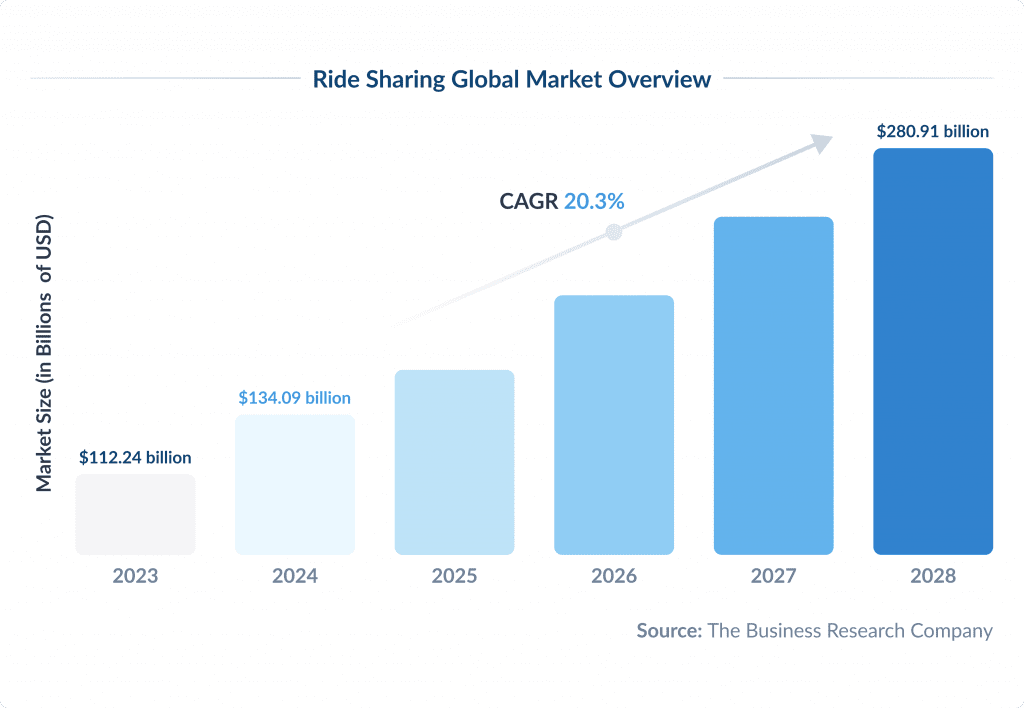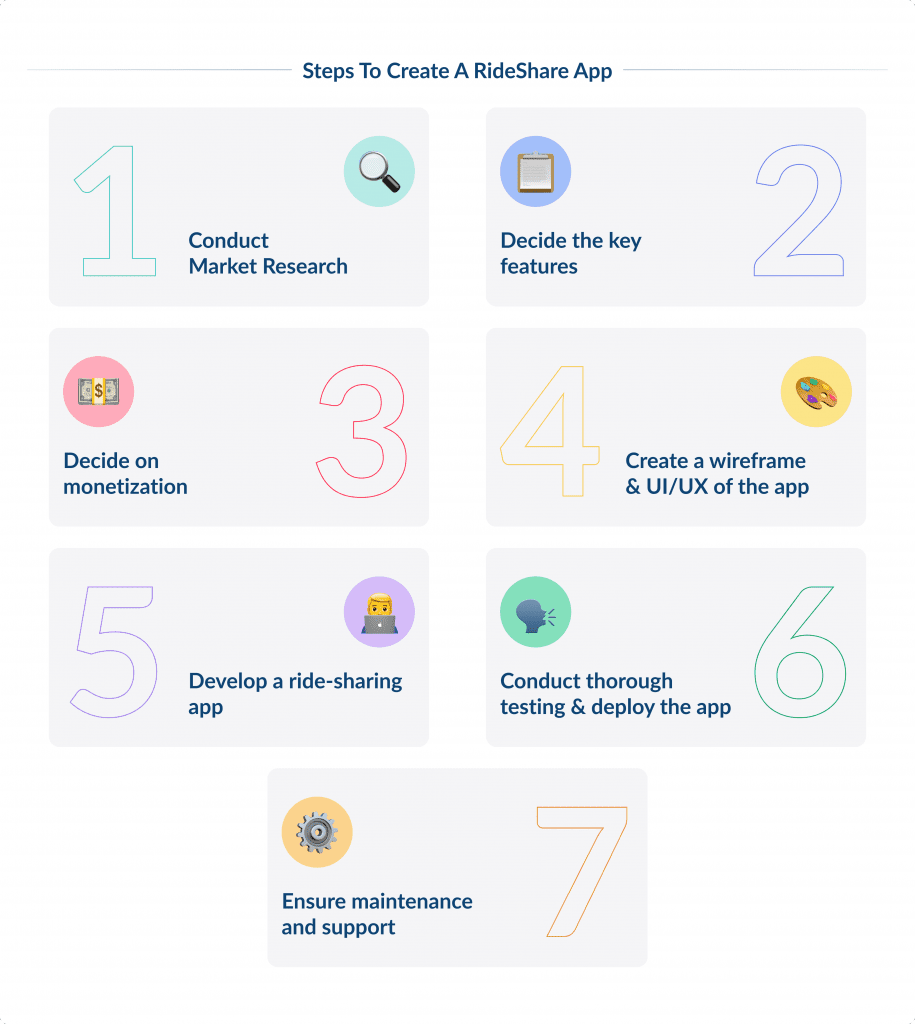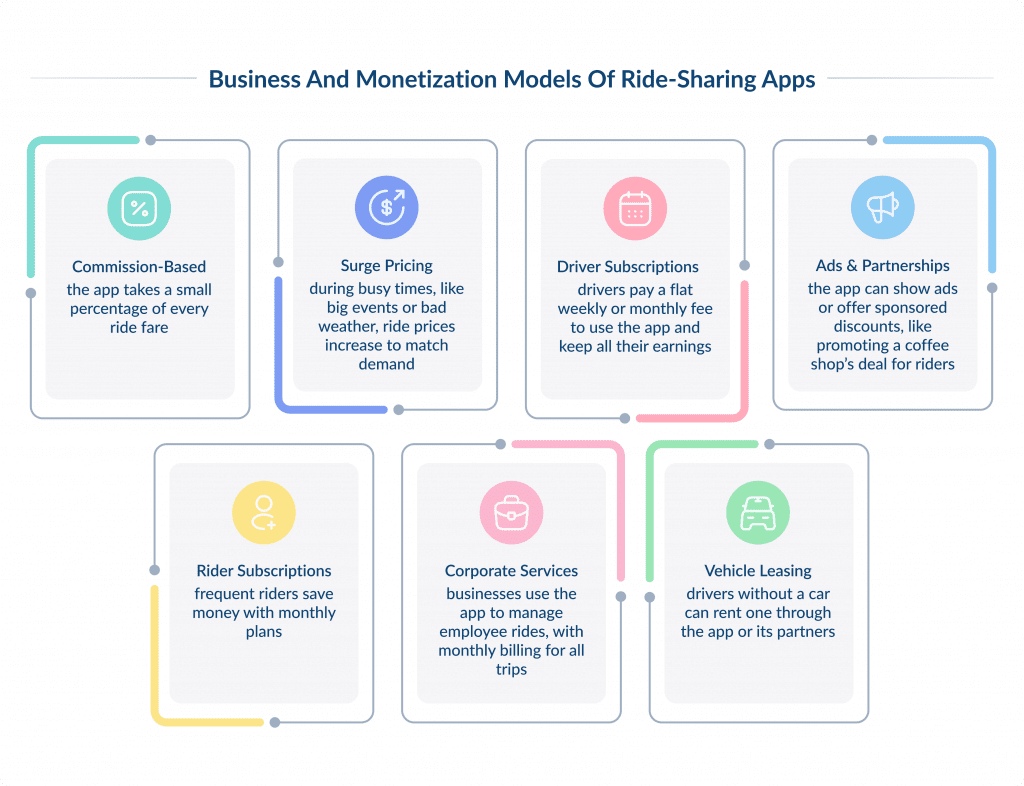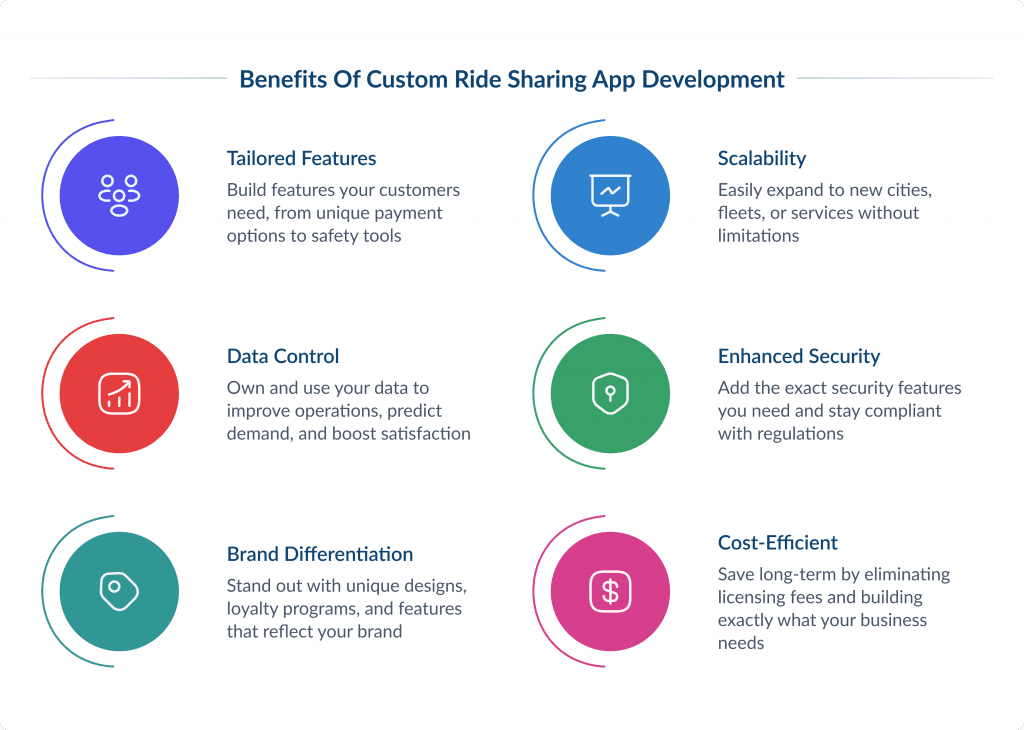Ride-Sharing App Development: Features & Costs
- Updated: Jan 31, 2025
- 18 min
If you are already familiar with the ride-sharing industry, you know how competitive it can be.
What if you could elevate your service and provide a more seamless, user-friendly experience while cutting down on operational costs?
This is possible with developing a custom ride-sharing app.
Ride sharing app development can help you unlock new opportunities to offer smarter rides, better driver-passenger matching, and features that cater to your unique audience.
Let’s discuss how our app development company can take your business to the next level with your own rideshare app.
Turning your app idea into reality? Learn how to start an app step by step.
Explore our app development services today
Ridesharing Market Overview
The ride-sharing market is growing fast, and now is a great time to jump in with new ideas.
According to the Business Research Company rideshare market report in 2024, the market was worth $134.90 billion, and it’s expected to grow by 23.3% every year until 2028.
This shows people are using ride-sharing services more and more. 
Why Is It Growing?
There are several reasons behind this outstanding growth of ride sharing business.
- Cars are getting more expensive
Owning a car costs a lot these days, with new features and tech driving up prices. Ride-sharing is an affordable alternative.
- Convenience
Apps make it easy for people to book rides, track them in real time, and pay securely. That’s why app-based platforms are so popular.
- Environmental focus
Electric vehicles (EVs) are becoming a big trend. People want eco-friendly options, and governments are supporting this shift too.
Why Should You Build A Rideshare App Now?
The market is growing, but it’s also evolving.
Customers are looking for ride-sharing solutions that solve their problems in better ways — faster bookings, cleaner energy options, and more tailored services.
If you enter the market now with a fresh idea or feature, you can carve out a unique space and build loyalty among users.
Steps to Create a RideShare App
Ride sharing app development is a complex process and depending on the mobile app development company you choose to work with, the approach might differ.
Here is how we conduct ride sharing mobile app development services at SpdLoad.
Step 1: Conduct Market Research for Your Ride Sharing App
To create a rideshare app, we start by asking, “Who is your app for?”
This isn’t just about demographics like age or location, though those are important.
We dig deeper to uncover your target audience’s habits, pain points, and expectations.
For example:
- Are they budget-conscious or willing to pay for premium services?
- Do they prefer instant booking or scheduling rides in advance?
- Are there specific frustrations they face with current ride-sharing options?
We might use surveys, focus groups, or analyze online reviews of competitors to get this data.
This step ensures that every feature we design caters directly to your ideal users.
Ride-sharing is a competitive market, but that’s an advantage.
Why? Because it gives us plenty of data to learn from.
To create a rideshare app that outperforms your competitors, we analyze ridesharing apps like Uber, Lyft, and any regional competitors to find out:
- What features users love. For example, real-time driver tracking or in-app payment options.
- What frustrates users. Common complaints might include inconsistent pricing or unresponsive customer support.
- How they operate. We study their pricing models, driver incentives, and marketing strategies.
Do not worry that we will copy their rideshare app. We conduct the competitors research to figure out what gaps exist in the market and how your rideshare app can fill them.
Based on this knowledge, together, we identify your value proposition.
Here’s where we focus on what makes your app different.
Maybe you want to focus on eco-friendly options, like electric vehicles.
Or perhaps you want to provide a luxury experience with high-end cars and professional drivers.
We help you pinpoint this unique value and ensure it’s woven into every part of the app, from design to features.
Let's shape your startup's product vision together!
Step 2: Decide the Key Features
At this stage, we define the heart of your ridesharing app — its features.
These aren’t just buttons or functionalities; they’re the tools that make your rideshare app valuable and user-friendly.
At first, we will map out core features because every successful ride-sharing app has foundational features that users expect, such as:
- User registration and profiles
- Ride booking and matching
- Payment processing
- Ride tracking
These features create a baseline that ensures your app functions smoothly and meets basic user expectations.
We dive deeper into essential ridesharing app features further in this article.
Step 3: Decide on Monetization
Let’s talk about how your app will make money.
That’s the backbone of turning your idea into a successful business.
The right monetization approach is about crafting a strategy that works for your business and keeps your users happy.
At this stage, we help you choose the model that aligns best with your audience and business goals.
Whether it’s earning through commissions, offering premium subscriptions, or exploring other revenue streams, we’ll help you choose a path that supports both profitability and user satisfaction.
The goal is to find that sweet spot where you’re creating value for both your users and your business.
There are multiple monetization models you can choose from. We explore them in the next section of this guide.
Step 4: Create Wireframe and UI/UX of the App
Now we dive into the creative phase — this is where your app starts taking shape, visually and experientially.
We begin with wireframes.
Think of these as the skeletal framework, laying out where everything will go, from buttons to navigation paths.
From there, we move to UI/UX design.
This is all about creating an experience that’s as seamless as it is delightful.
User experience design focuses on functionality — making sure the app works effortlessly for drivers and riders.
Meanwhile, the user interface design adds visual polish, ensuring every screen is not just functional but also appealing.
Why is this important?
A great design isn’t just about aesthetics — it’s what keeps users coming back. If riders can request a car in seconds or drivers can accept rides easily, that’s the power of thoughtful design.
We also consider accessibility here.
Whether someone is a tech-savvy millennial or a senior citizen, the app should feel welcoming and easy to navigate.
Finally, we make sure the branding elements shine through so the app feels uniquely yours.
Startups often overlook branding—but a strong strategy can set you apart. Here’s how to develop a brand strategy.
Once this stage is complete, you’ll have a visual representation of your app that you can actually see and interact with.
Step 5: Development of Ride Sharing App
The development phase begins with building an MVP (Minimum Viable Product).
MVPs are a great way to start lean. Discover how to launch your MVP and set a strong foundation for your product.
Starting with an MVP ensures we focus on the core features first, allowing us to test the app with real users and gather valuable feedback early.
This helps refine the product, prioritize updates, and save resources in the long run.
An MVP includes the essential features your ride-sharing app needs to operate effectively:
- User registration for riders and drivers.
- Ride requests and matching based on location.
- Payment processing with secure gateways like Stripe or PayPal.
- Real-time GPS tracking using geolocation services.
Our rideshare app developers create a functional product that can attract users and establish its place in the market without unnecessary complexity.
Need a reliable development team? Here’s your step-by-step guide to hiring a dedicated team in Ukraine.
Front-End Development: Crafting the User Interface
Front-end development brings your app’s design to life.
Developers create a clean, responsive, and intuitive interface that matches the wireframes and UI/UX designs.
- For iOS, we use Swift or Objective-C.
- For Android, Kotlin or Java are preferred.
- Cross-platform development frameworks like React Native or Flutter allow us to build hybrid apps for both platforms simultaneously, saving time and ensuring consistency.
Back-End Development: Powering the App
The back-end ensures the app runs smoothly, processing data and handling critical functions like:
- Matching riders with drivers based on proximity and preferences.
- Storing user data securely with databases like PostgreSQL or MongoDB.
- Processing payments and managing transaction history.
We use scalable technologies like Node.js or Python to ensure the app can handle growth without compromising performance.
To create a ride-sharing app, a robust tech stack is essential for performance, scalability, and reliability.
- Geolocation services: Google Maps API and MapKit for real-time location tracking.
- Cloud infrastructure: AWS or Google Cloud for efficient data storage and scalability. See how Digital Ocean, AWS, and Google Cloud stack up on performance, cost, and features.
- Push notifications: Apple Push Notification Service (APNs) and Firebase Cloud Messaging (FCM) to keep users updated.
The foundation of any app is its stack — here’s how to choose a tech stack that ensures success.
Prioritizing Security and Compliance
Safety is a top priority for both riders and drivers. During development, we implement:
- Encryption protocols to secure user data in transit and storage.
- Secure authentication with two-factor authentication (2FA).
- Compliance with regulations like GDPR and CCPA to meet global standards.
Once the MVP is ready, we launch it for a small group of users.
Their feedback helps identify any issues and uncover opportunities to enhance the app.
From here, we iterate, adding advanced features like loyalty programs, advanced analytics, or multi-language support.
Step 6: Testing and Deployment of Your Ridesharing App
We follow an Agile discovery process, which means we break development into sprints.
Each sprint focuses on specific features, ensuring steady progress and room for adjustments.
- Unit testing checks individual functions.
- Integration testing ensures all parts work seamlessly together.
- Load testing evaluates how the app performs under high demand.
After testing, we deploy the app to the Apple App Store and Google Play Store.
We set up app store listings and make sure the carpooling app is compliant with platform guidelines, then, our developers submit the app for approval.
Once approved, your app is ready for the public!
Step 7: Maintenance and Support
After launch, we provide mobile app maintenance and support services if needed.
These include:
- Bug fixes to address any issues that may arise post-launch.
- Regular updates to add new features, improve performance, and stay current with platform updates.
- User feedback management to ensure the app evolves based on customer needs.

Features of a Ride Sharing App
A ride-sharing app works best when it’s designed with three clear roles in mind: Passenger, Driver, and Admin.
Why?
Because each group has unique needs, so you need separate these roles to provide everyone with a smooth and hassle-free experience.
Let me explain.
Passengers are the heart of the service — they’re the ones booking the rides.
Their app should feel simple and seamless, letting them request a ride in seconds, track the driver, and pay effortlessly.
Passenger Ridesharing App Features
| Feature | Description |
|---|---|
| User Registration | Easy sign-up using email, phone, or social media. |
| Ride Booking | Quickly book a ride by entering pick-up and drop-off locations. |
| Real-Time Tracking | Track the driver’s location in real-time on a map. |
| Fare Estimation | See the ride cost before booking. |
| Multiple Payment Options | Pay using credit/debit cards, wallets, or cash. |
| Ride History | View details of past trips, including fare and driver details. |
| Driver Rating & Reviews | Rate and review drivers to enhance service quality. |
| SOS Button | Emergency feature for contacting authorities or a pre-set contact. |
Drivers are the backbone of your business.
Their app should make their job easier, helping them accept rides, navigate to pick-ups, and track their earnings.
Drivers don’t need distractions. They need clarity and tools that help them stay focused and deliver great service.
Driver Ridesharing App Features
| Feature | Description |
|---|---|
| Driver Registration | Sign-up process with ID and vehicle verification. |
| Ride Requests | Accept or reject ride requests. |
| Navigation Assistance | Built-in map integration for easy navigation to pick-up and drop-off points. |
| Earnings Dashboard | Track daily, weekly, and monthly earnings. |
| Availability Toggle | Switch between online and offline modes to accept rides. |
| Ratings & Feedback | View passenger ratings and reviews to improve service. |
| In-App Chat | Communicate with passengers directly through the app. |
Admins are like the directors behind the scenes, making sure everything runs like clockwork.
Their tools let them manage passengers and drivers, solve disputes, and dive into analytics to figure out what’s working — and what’s not.
Admin Panel Features
| Feature | Description |
|---|---|
| User & Driver Management | Add, remove, or update passenger and driver profiles. |
| Ride Management | Monitor rides in real-time and resolve issues. |
| Payment Management | Handle payouts to drivers and track app revenue. |
| Analytics Dashboard | Access data insights like ride volume, peak hours, and revenue trends. |
| Dispute Resolution | Manage and resolve complaints from passengers and drivers. |
| Promo Codes & Discounts | Create and manage offers to attract more users. |
| System Settings | Adjust app configurations like service areas, pricing, or notifications. |
Why split these roles?
It keeps everything organized and avoids clutter.
Passengers don’t need to see driver tools, and admins need full control without logging into a regular user account.
You are giving everyone their own space tailored to their needs.
And by doing this, your ridesharing app becomes user-friendly, efficient, and ready to grow as your business takes off.
How to Make a Ridesharing App: Cost Estimation
Let’s talk about the budget you need to create a rideshare app.
The cost to build a rideshare app depends on things like the features you need and the team’s location.
Let’s dive into those aspects.
| Ride Sharing App Development Stage | Timeline | Estimated Cost |
|---|---|---|
| 1. Market Research | 2–4 weeks | $5,000–$10,000 |
| 2. Wireframing & Design | 4–6 weeks | $10,000–$20,000 |
| 3. MVP Development | 3–6 months | $30,000–$70,000 |
| 4. Full App Development | 6–12 months | $50,000–$150,000+ |
| 5. Testing and Deployment | 4–8 weeks | $10,000–$20,000 |
| 6. Maintenance & Updates | Ongoing | $5,000–$10,000/year |
The timeline for app development can vary — learn about the factors that influence it in our article on how long it takes to develop an app.
Rideshare App Development Costs Based on Location
Here’s a clear breakdown of rideshare app development costs based on the development team’s location.
These estimates assume a mid-sized app with standard features like user registration, ride tracking, and payment integration.
| Region/Country | Hourly Rate (USD) | Estimated Cost (USD) |
|---|---|---|
| Ukraine | $40–$50 | $90,000–$150,000 |
| Poland | $40–$70 | $120,000–$210,000 |
| India | $20–$40 | $60,000–$120,000 |
| United States | $100–$200 | $300,000–$600,000 |
| United Kingdom | $80–$150 | $240,000–$450,000 |
| Canada | $80–$150 | $240,000–$450,000 |
| Germany | $70–$120 | $210,000–$360,000 |
Business and Monetization Models of Ride-Sharing Apps
When creating a cost-effective ridesharing platform, the choice of monetization model is one of the most important decisions.
You want to find the perfect balance — making sure you generate enough revenue to sustain and grow while providing drivers with real value.
A model that doesn’t fit could mean overcharging your users, driving them away, or undercharging and struggling to cover costs.
But when done right, you can create a steady income stream, keep customers happy, and stand out in a competitive market.
Let’s explore the monetization models to choose for your ridesharing app.
1. Commission-Based Model
This is the model used by most ridesharing apps like Uber and Lyft.
The rideshare app takes a percentage of the fare from every ride completed.
For example, if the fare is $25 and the app charges 25% commission, the app earns $6.25 and the driver gets $18.75.
This model scales with more rides and keeps the platform incentivized to attract riders and drivers.
Apps often adjust commission rates based on driver location, ride type (economy vs. luxury), or promotional periods.
This provides flexibility for the business while keeping drivers engaged.
2. Surge Pricing (Dynamic Pricing)
This model uses supply and demand to maximize earnings.
During peak hours, bad weather or big events, the fare prices increase automatically.
For example, a $15 ride could become a $30 ride if demand exceeds driver availability.
The app earns more from higher commissions during these periods.
Often, on New Year’s Eve, ride prices often skyrocket because of high demand.
Apps like Uber explicitly display surge pricing to users, ensuring transparency while boosting earnings.
3. Subscription Plans for Drivers
This model replaces per-ride commissions with a flat fee for access to the app.
Drivers pay a weekly or monthly subscription fee to use the app, often in exchange for 100% of their fares.
For example, a driver might pay $50 a week and keep all their earnings.
This gives drivers steady income regardless of ride frequency.
Subscription plans are attractive to high-volume drivers who want predictable costs and no percentage-based deductions.
4. Advertising and Brand Partnerships
The app shows ads, promotions or sponsored content to the user.
For example a coffee shop might pay the app to show ads for discounts on coffee for riders who stop by their stores.
Additional Revenue Streams:
- In app ads for both riders and drivers.
- Sponsored ride discounts (e.g. “Ride to X Mall for 20% off”).
- Corporate partnerships for ride branding.
This adds revenue streams and value to the user through promotions.
5. Ride Passes or Rider Subscriptions
For frequent riders, this model builds loyalty and savings.
Riders pay a fixed fee for discounts or ride bundles.
For example, a $25 monthly pass might be 10 rides at 20% off or free delivery on certain services.
Predictable revenue from subscriptions gives the app financial stability.
Riders will be more loyal if they feel they’re getting value from their subscription.
6. Corporate or Business Services
Apps can tap into the B2B market by offering business solutions.
Companies partner with the ride-sharing platform to provide transportation for their employees or clients.
The app bills the business monthly for all rides taken under the corporate account.
Uber for Business allows companies to set up accounts for employee transportation with features like ride limits, expense tracking and pre-approved destinations.
The benefits of this approach are steady revenue from long term contracts and higher ride volume.
7. Leasing or Renting Vehicles
This model lowers the barrier for drivers who don’t own a car.
Apps partner with car rental companies or offer their own fleet for drivers to rent at a fixed weekly or monthly fee.
For example a driver might rent a car for $200 per week and use it only for ride-sharing.
The app earns from rental fees and has a guaranteed supply of vehicles for the platform.
Uber’s “Uber Vehicle Solutions” program connects drivers with leasing and rental options so more people can join the platform.
With so many options available, which one should you choose?
Ride-sharing apps often combine several models to maximize revenue.
For example, Uber uses commission-based earnings, surge pricing, corporate services, and advertising partnerships simultaneously to generate multiple income streams.
This diversification allows ride-sharing businesses to mitigate risks, enhance user satisfaction, and maintain steady growth.
However, keep in mind that each model should align with the app’s target audience and market dynamics to succeed. 
Benefits of Custom Ride Sharing App Development
If you consider developing a custom ride sharing app, you’re not just building another transportation platform.
You’re creating a solution tailored to your unique business needs.
Custom ride sharing app development offers you full control over how your app functions, its features, and how it evolves over time.
Here’s why opting for a custom ride-sharing app is a smart decision:
Tailored Features and User Experience
With a custom ride sharing app, you get to decide exactly how it works.
Want to offer unique payment options, specific safety features, or a special booking system?
You can build it all to match what your customers need and what your brand stands for.
The best part is that you can update or add new features as you grow and learn more about your users.
Scalability and Flexibility
A custom ride sharing app gives you the ability to scale your business as you grow.
You can add new cities, expand your fleet, or introduce new services seamlessly without being restricted by pre-built app limitations.
As your business needs evolve, a custom solution allows you to make changes and improvements on your terms, providing long-term flexibility.
Data Control and Insights
With a custom app, you own the data.
This means you can collect, analyze, and leverage insights about customer preferences, ride patterns, and operational efficiency.
You can use this data to optimize routes, adjust pricing, forecast demand, and improve customer satisfaction.
Unlike third-party apps, where your data might be shared or limited, custom development gives you full ownership of the valuable data you gather.
Enhanced Security and Privacy
Security is a huge concern in the ride-sharing industry.
With a custom-built app, you can implement the exact level of security you need, including encryption for payments, background checks for drivers, and secure storage of personal data.
You can also stay compliant with regional regulations and adapt your app to meet specific legal requirements, ensuring that both your drivers and customers are protected.
Brand Differentiation
Custom ride sharing app development allows you to create a unique app that stands out in the market.
You can integrate features and design elements that reflect your brand’s personality and mission.
Whether it’s a smooth user interface, loyalty programs, or creative marketing features, a custom app helps you create a distinct identity in a competitive ride-sharing market.
Improved Integration with Other Services
A custom app allows you to easily integrate with other services or technologies that might be vital for your business.
For example, you can integrate unique payment gateways, analytics tools, customer support systems, or even offer partnerships with local businesses for promotions.
The flexibility of custom ride sharing app development makes it easier to adapt to changing business environments and customer expectations.
Cost-Efficiency in the Long Run
Building a custom app might require a bigger upfront investment, but it can save you money in the long run.
Pre-built apps might come with licensing fees or limitations that force you to adapt your business to fit the software.
When you build a rideshare app that is tailored to your needs, you only pay for what you need and get the exact features that bring the most value to your business.
It will help you avoid unnecessary costs down the road. 
Win customers wisely
How We Made A Ridesharing App: Case Study
Let me share the story of a recent project we worked on, which was an exciting journey from start to finish.
The client came to us with a dream to make a rideshare app that offers premium, eco-friendly ride-sharing for their users.
The goal was simple: create a ride sharing app that wasn’t just another ride service but something that elevated the whole experience for the passenger.
We built the app from the ground up, we did it all from design to mobile app development.
We kept it simple: make it easy and fun for the user.
We focused on user experience and speed, so the app would be intuitive, fast and feature packed.
We chose a solid set of frameworks and tools that would bring the dream to life and run on both iOS and Android.
For more detailed information, check out these detailed guides on Android app development costs and iOS app development costs to better navigate the financial aspects.
What We Did
For geolocation, we used CoreLocation for iOS and Google Location API for Android, making sure that users could track their rides in real-time with pinpoint accuracy.
We integrated MapKit for iOS and Google Maps API for Android to provide seamless navigation and accurate, point-to-point directions for both passengers and drivers.
This way, users wouldn’t face delays while traveling from one point to another, making the experience as fast and efficient as possible.
The payment process was a critical part of the app, so we added multiple payment methods like PayPal, Stripe, Apple Pay, and Google Wallet.
This offered users the flexibility to pay however they preferred, making the process smooth and hassle-free.
Focus on User Experience
The app design process was focused on creating a simple yet efficient solution.
One tap and you can request a ride and the app will match you with the best driver based on your previous preferences.
No holding or calling — everything is fast and easy.
You can see the driver’s photo, vehicle details and estimated time of arrival.
The Team Behind the Project
Developing this app was no small feat.
It required a dedicated software development team consisting of backend and frontend developers, solution architects, and quality assurance testers.
Our team worked together for over 1100 hours to ensure that every feature was spot on, with an additional 168 hours spent rigorously testing the app for quality.
The Result
The final product was a user-centric, luxury ride-sharing app that met the market’s needs and exceeded expectations.
The app allows for quick ride requests, easy payments, and gives passengers a personalized experience based on their preferences.
The seamless integration of maps, payments, and geolocation ensures that everything works smoothly, providing a top-tier service.
This project was a prime example of what can happen when custom development is used to create a truly user-centered product.
With a focus on simplicity, efficiency, and the right set of tools, we were able to turn an idea into a world-class ride-sharing app that customers love to use.
Feel free to explore the full collaboration story in this taxi app development case study.
Wrapping Up: Here’s The Key To Create A Ride Sharing App
Creating a ride-sharing app requires more than just technical know-how – it requires a deep understanding of the market, the right features, and the ability to deliver a seamless user experience.
Our app development team has a proven track record of developing robust, user-friendly apps that solve real-world problems and drive business growth.
From the initial concept to post-launch support, we’ll be with you every step of the way to ensure your app is optimized for scalability, security, and profitability.
We know what works in the industry, and we’re committed to helping you create a ride sharing app that not only meets your goals but exceeds user expectations.
Contact us and let’s build a rideshare app together!
If you are looking for ways to enhance your development, AI is a game-changer. Check out the AI development tools we use for software development. These tools enhance our projects and streamline development workflow.













